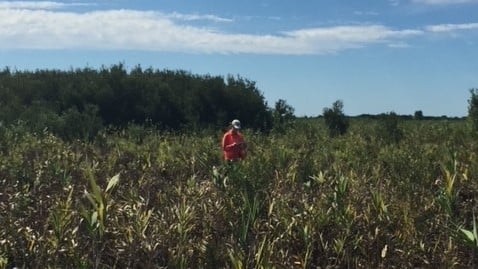To Reduce Greenhouse Gas Emissions From Wetlands, Just Add (Fresh) Water

Scientists found they could reduce overall greenhouse gas emissions from a former coastal wetland in North Carolina by raising the groundwater level – recreating conditions similar to what existed at the site before it was drained.
In the recent study published in the journal Wetlands, researchers reported increases in average emissions of two potent greenhouse gases – methane and nitrous oxide – but that those increases were more than offset by larger reductions in carbon dioxide.
In fact, they estimated that the restoration reduced emissions by the equivalent of 9.6 tons of carbon dioxide per acre in the first year – which is roughly as much as the emissions from two gasoline-powered vehicles for a full year, according to the U.S Environmental Protection Agency Greenhouse Gases Equivalencies Calculator. Researchers said the findings support wetland restoration as a possible climate change solution.
“What people are concerned about with this strategy is if you increase methane or nitrous oxide emissions a lot, you could potentially negate any improvement in overall emissions,” said Marcelo Ardón, corresponding author of the study and an associate professor of forestry and environmental resources at North Carolina State University. “But in our case, that did not happen. The carbon dioxide reduction was like an order of magnitude higher than the increase in the other two gases.”
The Abstract spoke with Ardón about the study, and the potential for wetland restoration to fight climate change.
The Abstract: Your study took place in “shrub-bog peatlands” of North Carolina, in the Pocosin Lakes National Wildlife Refuge along the coast of North Carolina. What are peatlands?
Marcelo Ardón: Peatlands are areas that have a lot of carbon in the soil from un-decomposed plants. Here in North Carolina, we have a type of peatland on the coastal plain, the shrub-bog peatland, which we also call “pocosins.” The plants there are very productive. The soils have a good amount of water from precipitation, and they’re also very acidic, so the dead plants end up decomposing very slowly. That combination of high plant productivity and slow decomposition mean the soils accumulate a large amount of carbon.
Part of the problem, particularly here in North Carolina, and in a lot of the Southeast, is a lot of these peatlands were drained to be put into agriculture. And when you drain them, the soil becomes dryer and the plant material is more likely to decompose. When that plant matter in the soil decomposes, it starts releasing more carbon dioxide, a greenhouse gas that contributes to climate change.
TA: What solution did you study?
Ardón: We studied the impact of raising the water table in these shrub-bogs. By raising the water table, we wanted to see if we could decrease decomposition, and decrease the amount of carbon dioxide coming from the soil. Our collaborators built a berm around the ditches, as well as water control structures to control the water level.
TA: What did you find?
Ardón: Even though average emissions of methane and nitrous oxide increased after the restoration, their fluxes were much lower, so the increase in both of those gases did not negate the decrease in carbon dioxide. The decline in carbon dioxide was so large that the increase in the other gases did not make a difference.
TA: How is sea-level rise harming coastal ecosystems, while this solution is helping?
Ardón: When there is saltwater coming into freshwater systems due to sea-level rise, that creates a lot of problems that you see with ghost forests. In this study, the goal was to restore the hydrology of the system to resemble what we think it used to be like – a freshwater shrub/bog wetland – before the ditches and the drains were put in. This is a system that used to be pretty wet, and then we put these ditches and canals in order to lower the water table to turn the wetlands into agricultural fields.
TA: What are the long-term benefits of this strategy?
Ardón: I think this is a potential climate change solution. In this study we were just looking at the greenhouse gas emissions, but there are other benefits of hydrologic restoration. We can recover some of the plants that have been lost when you restore the hydrology, and create habitat for wildlife. These systems are also pretty good at cleaning water. There is a lot of potential good in doing more of this; it’s just a matter of finding funding to do it, and convincing landowners. The majority of these drained peatlands are on private property. We need to have the right kind of financial incentives for this kind of restoration. By quantifying this reduction in carbon dioxide, we can help support a methodology for creating carbon credits from restoration of these drained peatlands. So this could help us raise money to fund restoration, or incentivize private landowners to do this work.